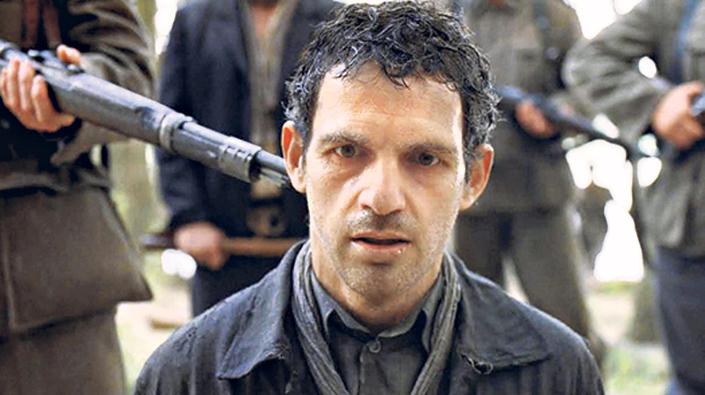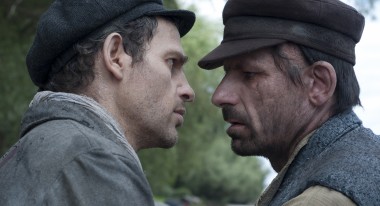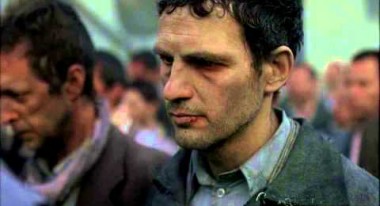 Back to selection
Back to selection
True Crit
Weekly film reviews. by Howard Feinstein
The Designated Mourner: Son of Saul
 Geza Rohrig in Son of Saul
Geza Rohrig in Son of Saul “You failed the living for the dead,” Abraham (Levente Molnar) chides fellow Hungarian Jew Saul Auslander (Geza Rohrig) in the bowels of Auschwitz-Birkenau in October, 1944. It’s a damning comment, almost a charge of treachery: That is the occasion for the single act of resistance by camp inmates against the occupying Germans. Given recent Russian advances, the Nazis pushed to quickly liquidate not only those who had defied the odds, who had survived unimaginable brutality, epidemics, and freezing temperatures, but also the camp’s naïve newcomers right upon arrival.
The latter actually believed they were disrobing for a group shower before a promised reward of hot soup. They accepted at face value the promise that immediately afterward, they would find out their work assignments, similar to the professional and artisanal jobs they plied back home, before the Teutonic invaders packed them into freight cars for the long, painful journey to high-tech, efficient factories that were not productive, but just the opposite. These industrial facilities functioned solely to destroy — to exterminate Jews, Gypsies and others considered excess baggage (e.g., Communists and homosexuals) in a delusional effort to pare down the social order to a pure, homogeneous Aryan race.
In Laszlo Nemes’s Cannes prize-winning Son of Saul, Abraham and Saul are members of the Sonderkommando, a special unit of Jews selected to do the dirty work required to achieve the Nazis’ long-term goal. Their daily schedule begins as soon as the heavy metal doors to the gas chambers close: They gather clothing just removed and placed on hooks outside, and rifle through pockets for valuables. After toxic chemicals have been released and taken effect, they stack the Stucke (“pieces”) — dehumanizing German slang for the corpses of those who only minutes earlier were screaming and banging their fists against the walls. Then they move them away to make room for yet another batch of arrivals.

(For years members of the Sonderkommando got a bad rap, in part because intellectuals like Hannah Arendt and Primo Levi assumed they had sold out their own people. But they had nothing to gain from the association: They knew that their time was limited, three or four months max. Many documented the details of the camp for posterity — the “Scrolls of Auschwitz” are first-hand accounts that were buried and discovered years after the war ended. In the film, Saul and a photographer smuggle in a camera to take pictures of the guards in action. They fail on account of smoke in the air, but Saul does save the day with a courageous act that elevates his standing among the others. As in any prison, a favor bank and system of bribes surface among the Sonderkommando, as do power politics. In one scene, one of its leaders shamelessly butters up a German officer, and in another, perhaps two minutes on, that same man abuses his privileged position at the expense of Jews with lower status. Director Laszlo Nemes wants to set the record straight about the Sonderkommando, middlemen of a sort who have little choice but to play it both ways.)
Operating from both a formal and ideological perspective, Nemes avoids filming the act of dying; he shoots nothing more than what Saul himself is able to see or be part of. Regulating access to visual and aural information by linking it to Saul’s perception plops the spectator into what Nemes calls an immersive experience, exposure to fragments of Saul’s reality, which ultimately bind in a larger, more comprehensible narrative. (The use of shallow focus limits how much imagery is available at any one time.) Once the showers and changing area are emptied out, the Sonderkommandos drop to their knees on the tile floor and start scrubbing, forcefully, cleaning and disinfecting. This might at first seem a bit facile, but I think you can see in this exhausting motion, repeated so often it functions as punctuation, something of the Germans’ attempts to erase history. There is much off-screen noise, whether it be soldiers speaking German, or scratchy music on a loudspeaker. This, of course, opens up the physical space, the sounds providing cues when images are carefully parceled out.
You will most likely also find a metaphor here for the impetus behind the entire film project. The Sonderkommandos had precise tasks but essentially no backstories. It’s an exhausting but simple life. Information is relayed from inside a twisted maze of activity. Nemes rejects embellishment (the building in which most of the action takes place is a simple concrete structure), identification with characters, the aesthetic veneer of most films about the Holocaust. It is as if he, DP Matyas Erdely (who also shot James White, Miss Bala, Delta, and Tender Son: The Frankenstein Project, all gorgeous), and production designer Laszlo Rajk pooled their areas of expertise and resources in order to wipe away the false stereotypes and thin beauty of these other types of representation that they find distasteful when used in conjunction with genocide.

Going back to Abraham’s assertion, how did Saul fail the living for the dead? The film has a double narrative. The living are the prisoners who are prepared to fight, who have bravely taken steps to bring in ammunition and organize themselves. Unfortunately, Saul, who is thought to be off-beam to begin with, screws up the one indispensable chore he commits to take care of for the benefit of this group. Which brings us to the other narrative, which is in perpetual conflict with the first: It deals with the dead.
Here, it is a boy, barely in his teens, amazingly still breathing when the heavy doors to the gas chamber are propped open. This had happened only once before. Of course he is not allowed to live. Saul, who sees it all unfold, becomes obsessed with him. The kid’s temporary victory is for Saul an act of defiance, and a retort to the objectification of the prisoners. He refuses to become a piece. He is the only dead Jew whose features are defined. Nemes keeps the others blurred, out of focus, as if distinguished by a martyr’s aura. Again, the strategy is a function of Nemes’s tact and respect.
Saul’s mission becomes a proper burial for the boy, accompanied by such established religious rituals as the recitation of the Kaddish. His search for a rabbi becomes a spectacular wild goose chase. You can’t be certain of his motivation: He claims that this kid is his son. In his mind, that is certain. To survive, he has mastered the art of blocking out almost everything that takes place around him. It’s ugly, and his job precipitates an intense internal moral dilemma that we sense primarily from Rohrig’s subtle facial tics.
A problem comes up when Saul’s individual project interferes with the larger one of the group. He calls too much attention to himself, whether in marching formation (he is constantly rubbernecking), or in his work space: He’s too involved in finding a rabbi to even notice. At the same time he also attracts attention to the comrades preparing to revolt. Several times he is pulled aside by the Germans for his suspicious behavior, but Saul is a quick thinker, creatively inventing plausible excuses. In the search, he runs through four or five rabbis, some most certainly poseurs, ending up with a Greek man called The Renegade (Marton Agh), who cannot even say Kaddish. His fierce dedication to the boy and the fate of his body — he tells the camp doctor (Sandor Zsoter), also a Jew, that he does not want him “cut” or experimented with — frequently clouds his judgment.
So much happens simultaneously that Nemes uses long takes out of necessity to capture the hysteria of it all. Much of the film is shot in jerky fashion with one of two handheld 35mm cameras. (Adrien Hod’s choreography is exemplary, not only in the way the men move around one another, but in Saul’s maniacal shifts in direction, turning 180 degrees in a half second, or wandering off nimbly from the others, camera close behind.)

Still, Saul’s solitary mission serves the supernarrative of the film. Pursuing his chosen mitzvah, he comes across a number of people and situations that he would otherwise not encounter. We get to know the doctor, who straddles two worlds, because Saul has to enter his office and the autopsy area. That is where some of the most telling confrontations occur, such as when a Nazi officer makes fun of this shtetl boy with overdrawn gestures and a humiliating faux-folk dance. Later he goes into the women’s quarters. We gain a glimpse of their work (stashing the suitcases of newcomers), as well as the sexual tension one young woman passing him explosives feels in his presence.
Several scenes suggest a homosexual attraction on Saul’s part for the boy, who has a beautiful face and body, more androgynous than conventionally male. He breathes heavily when he wipes him down, one of the requisite rules for burial. He turns away from the attractive female. Abraham reminds him how he used to talk about women, but no longer does. If the truth be told, Saul is so enigmatic that it is difficult to determine with certainty what drives his mission.
No spoiler here, but I must point out that Nemes brilliantly ties the two principal narratives together. The dual story lines coexist. The film is hardly optimistic, but the one thing this gifted filmmaker grants us at the point of convergence is surprising closure that is an inspired game changer.
